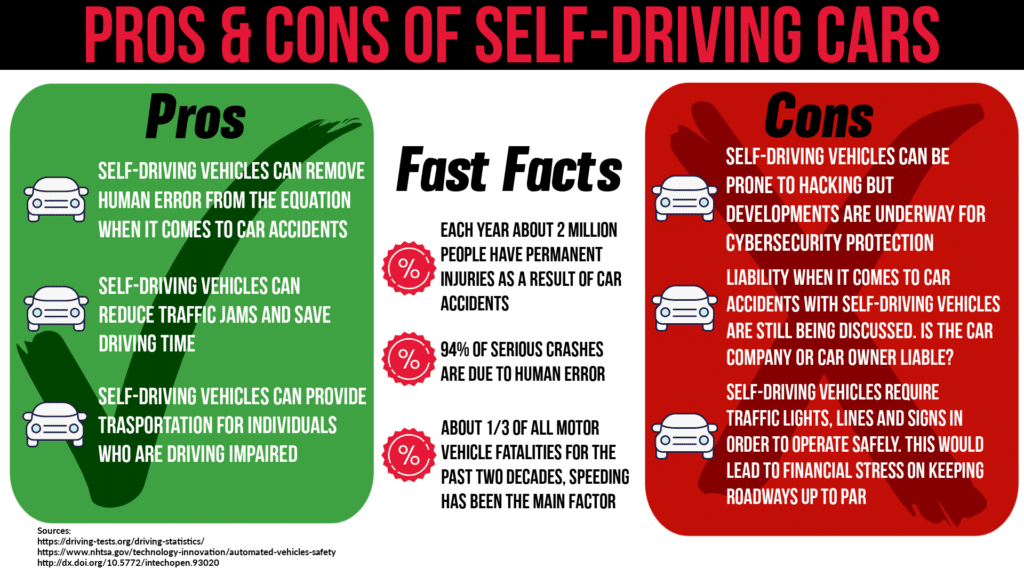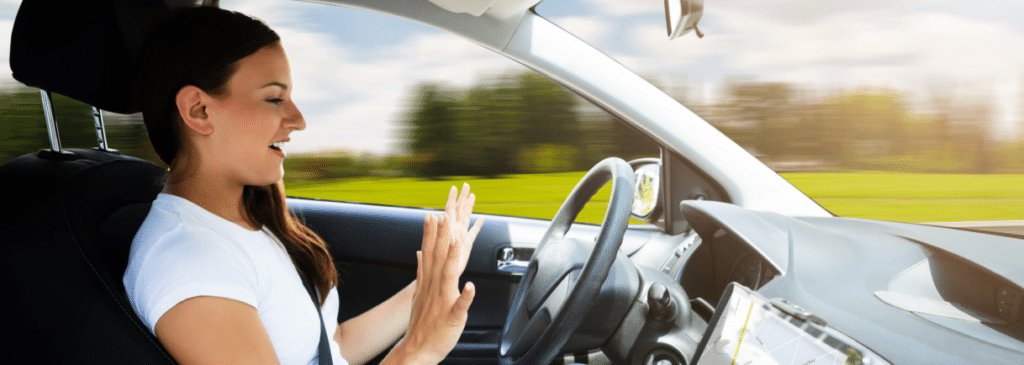
How Do Self-Driving Cars Work?

Before we can discuss if self-driving cars are safe, we must understand how they work.
Have you been in a car that beeps when something is in the way when backing up the car? Have you seen the light indicator on the side mirrors that light up when a car is in your blind spot? Or have you seen the cars that will automatically open or close the trunk just by sticking a foot out by the sensor? Well believe it or not, these types of car advancements have had a big impact in car automation and getting us closer to self-driving cars. In any futuristic movie, cars seemed to be the one thing that is the most evolved! Whether it was flying cars or cars that could also travel on water, we have always been intrigued with car technology and how far we can take it.
Big named car companies like Tesla have been getting closer and closer to achieving these futuristic car fantasies. But how do they work? How have they been able to achieve “auto-pilot”? The Society of Automotive Engineers, or SAE, have come up with 6-level standard that helps us identify types of automation within cars.
LEVEL 0 – No automation
- This is the most basic for of cars. The one we are all familiar with. The driver has full control of the car. Most of the world’s driving population is at this level. Most of us who have no experience with automation and most of us still wondering if self-driving cars are safe, safer than human drivers.
LEVEL 1 – Driver Assistance
- This includes steering assistance for the driver if the car starts to drift into another lane or braking for the driver if the car in front randomly slows down/slams on their brakes. However, the car cannot perform both tasks at the same time. Driver must be focused at all times on the road.
LEVEL 2 – Partial Automation
- As previously mentioned in Level 1, the steering assistance and brake assistance can be performed simultaneously, if required within Level 2. This is typically where you would find Tesla cars. Their Full Self-Driving Autopilot System, or FSDAS, is engaged, the car only requires that the driver keeps their hands on the steering wheel while the car changes lanes, speeds up or slows down in traffic. Drivers still need to pay attention to the road and what is going on around them within this Level 2 automation.
LEVEL 3 – Conditional Automation
- This is where the driver becomes less important and is no longer “driving” the car. However, the driver still has to pay attention to the surrounding environment in case they need to take over the vehicle. A steering wheel and pedals would still be included in these types of cars.
LEVEL 4 – High Automation
- Drivers in this level are no longer required. You can become a passenger in your self-driving car. The pedals and steering wheel wouldn’t be included in these cars because they would become obsolete. There are still conditions needed to be met for the car to operate to capacity. Google’s Waymo is considered to be a Level 4.
LEVEL 5 – Full Automation
- The car has full control and would be able to operate under any conditions. Users of the self-driving car would be able to input a destination and the car would take them. These self-driving cars would be able to obey traffic signs, lights, stay in lane, and go the speed limit.
A lot of recent articles surrounding these self-driving cars throw out the words “autonomous” or “automated” when explaining how self-driving cars work. But what do these words mean? Automated, or automation, means that the car has a built-in set of rules it has to follow. For example, when you put in a destination the car will take you straight to the destination, self-park and pick you up when ready. Autonomous means that the car would be self-aware. For example, when you put in a destination the car might notice that it is low on fuel and go to the nearest charging/gas station without getting you to your destination first. Does this make self-driving cars safe? Some say yes. As a car becomes more “intelligent”, it can aide in its own safety operation, working with drivers to increase response time, awareness, and overall safety.
What are the Dangers of Self-Driving Cars?

Why self-driving cars are not safe and what is being done to change that. With all things, there will be dangers surrounding new technologies. Just like app or software updates, there will be bugs and cause things to mess up. But when it comes to a self-driving car you are trusting to get you from point A to point B, manufacturers are being very diligent with their models.
So, how will the self-driving cars be safe? All self-driving cars use sensors, algorithms and high-tech learning systems in order to drive with little to no human assistance.
Tesla plans to combat any dangers by consistently updating their software systems in all of their vehicles. Ensuring that cars are always up to date with the latest technology and that all self-driving cars are as safe as they can be. Tesla plans to use their extensive data collection from all their cars in order to understand unique driving patterns and learn how most car accidents occur. They will be able to apply this data into their software so their self-driving cars will be able to have a wide variety of “experience” so the cars would know how to react under any circumstances. With every software update, the cybersecurity will be getting stronger in the self-driving cars as well. The great thing about that is you don’t have to bring in your Tesla to be updated, it would be similar to how you would update your phones software from your home.
Concerns with LiDAR and weather are being tested under all conditions. LiDAR, or Light Detection and Ranging, is what these self-driving cars would use to know the distance between itself and surrounding cars on the road. LiDAR is expensive and begs the question of interference with other self-driving cars using the same technology. If there are many cars on the road, how would their depth detection be affected? Similar to weather, when it snows and the lane lines are covered, will the self-driving car know where the lane is? Or in thunderstorms with heavy rains, would the sensors be affected as well?
Then the most concerning question, how would these self-driving cars do with other normal cars on the road and if there is an accident caused by a self-driving vehicle who would be at fault?
Who is At Fault if a Driverless Car Caused a Car Accident?

Now to answer the question most of the world is wondering, are self-driving cars safer than human drivers? As we know 94% of serious car accidents are caused due to human error. Drowsiness, internal car distractions, driving under the influence, speeding/reckless driving and being driving impaired are all reasons why accident occur. Self-driving cars are thought to eliminate these human errors and reduce the amount of accidents that occur every year. This means that self-driving cars would be safer than human drivers. But what happens when you get into a car accident with a self-driving car? What happens if it you aren’t at fault?
There has been a lot of discussion over the matter. If the car is truly a self-driving car that is driverless (a lever 4 or 5 on the SAE Standard), the consensus is that the manufacturer would be at fault for the car accident. It’s true, the car manufacturer is supposed to ensure the safety of the car itself as well as the safety for other drivers on the road. No driver is a perfect driver and accidents happen, the same can also be said for these driverless cars.
However, if we take a look back at the SAE Standards Level 2 and 3 cars still have drivers that are supposed to be paying attention to the road and take over if need be. In these instances, the driver would be at fault not the manufacturer. Human error is still in play here, the car isn’t completely automated. When behind the wheel of a Level 2 or 3 car, you shouldn’t put all your trust that your car will react correctly to avoid accidents. These cars are not reaching the qualifications to be standardized as driverless cars. Your safety is still in your own hands.
If you have been involved in a car accident and need assistance, call our office. Our team of personal injury attorneys and car accident lawyers are here for you during this difficult time. We will review the details of your accident and help you determine what steps to take next. Call today to schedule your free case evaluation and discover more about how we can help you.
Sources:
